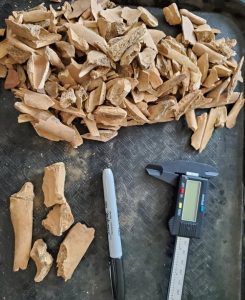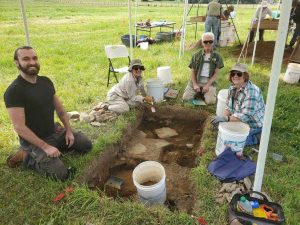How Economics Nearly Drove New England’s White-Tailed Deer to Extinction
With a desire to learn why people overuse natural resources, recent UConn Department of Anthropology graduate and affiliate research scientist Elic Weitzel ’24 Ph.D analyzes centuries-old deer bones to study unsustainable practices of the past to help lend insights into how we can avoid making the same mistakes and instead work toward a sustainable future.
In research published in the Journal of Anthropological Archaeology, Weitzel builds upon his previous historical ecological studies on deer in precolonial New England to detail how the population changed post colonization. Estimated at around 30 million in what is now known as precolonial North America, the white-tailed deer population was overhunted and experienced a steep decline to between 300,000 and 500,000 at the beginning of the 20th century.
“Essentially, we know a lot about white-tailed deer from historical records and accounts, but much of that hasn’t been synthesized fully with the archeological data yet,” says Weitzel, who is now a Peter Buck Postdoctoral Research Fellow at the Smithsonian National Museum of Natural History. “With this paper, I started to bridge that gap, as a lot of my previous work focused on precolonial archeological sites, and in this paper, I’m looking at a 17th century site.”

Weitzel analyzed white-tailed deer bones from two sites in the Connecticut River Valley. One site represented the precolonization time period, and the other represented the 17th century. He looked for evidence indicating the age of the animal and the animal’s body size, while also noting the abundance of bones of animals at different ages. More juveniles indicate higher hunting pressure, as hunters generally only take yearlings and fawns if they can’t get enough large adults.
Weitzel found that white-tailed deer populations appeared to thrive prior to European colonization, when deer were large and abundant, with little to no evidence of hunting pressure from the Indigenous population. However, things soon changed.
“Comparing the precolonial pattern to the mid-to-late 17th-century data set, the deer populations started to decline pretty early. A lot of the historical accounts focus on declines in the 19th century, but this paper, I think, finds some early evidence that it started very soon after Europeans showed up,” Weitzel says.
A common explanation for animal population declines is overexploitation by a growing human population, which would have negatively impacted deer in the 18th and 19th centuries, but Weitzel says that doesn’t appear to be the case in the 17th century.
“Native Americans were eating the meat, using the hides, using the antlers and the bones for tools and things, and they were certainly exchanging these deer and deer products to some extent,” says Weitzel. “But with the arrival of Europeans in the 17th century, you’re now integrating New England into the early mercantile capitalist economic system with new pressures, and deer as a natural resource are now being valued in a new way that’s designed for going after profit more than the utilitarian needs of people.”
Weitzel says this case study yields interesting and vital lessons for understanding sustainable natural resource use.
“The precolonial pattern, where white tailed deer populations were doing well prior to the arrival of Europeans, speaks to some level of sustainability in these Indigenous economic systems,” Weitzel says.
One notable contrast between the systems, for example, is the vastly different definitions of what it meant to “own” the land. For Europeans, this meant that purchase gave full rights to use the resources however the owner wanted, even if it meant destroying that land, which is a very different definition from Indigenous understandings of ownership, says Weitzel.
Another important insight from Weitzel’s work counters a popular and contentious argument for sustainability, that human populations put pressure on resources, therefore the best solution is to reduce the human population. Weitzel found human precolonization population levels were higher than in the 17th century, meaning that the hunting pressure on the deer population was not correlated with higher human populations.
“All else being equal, fewer people will consume fewer resources, so there is an inherent sustainability with that, but I think it’s more complex. There’s a different system of ownership and resource management in Indigenous societies that I think is probably contributing to whatever degree of sustainability we’re seeing,” Weitzel says.
Post-colonization, Native American populations declined precipitously, says Weitzel, due to disease and colonial violence. European settler populations were initially low and grew more rapidly in the 18th century, so the population argument falls flat because there was an overall human population low in the 17th century, when deer populations began to decline.
It’s not just the existence of people on a landscape that inherently causes damage, says Weitzel, pointing out that humans have been an integral part of all sorts of ecosystems for 300,000 years in the case of our species, and longer in the case of our hominin ancestors.

“Our species has had a wide variety of impacts on these ecosystems, and a lot of them have been beneficial and healthy,” Weitzel says. “It’s entirely possible for us, as just another animal, to integrate into these ecosystems in ways that are not inherently damaging.”
Weitzel argues it was the shift to valuing nature in light of economics, not some inherently destructive tendency of human nature, that was at play in causing the deer population to crash. The misanthropic tendency to think humans are inherently bad for the planet leads to advocating for reducing human populations, Weitzel explains, and this narrative is often pushed by think tanks and prominent environmental advocates.
“We must pay attention to the fact that even if you have fewer people, if the fewer people are still engaging in these extractive and exploitative economic practices, you’re still going to get ecological harm. Therefore, it’s not something inherent to our species or associated directly with large populations. In my mind, it really does come down to the economics,” says Weitzel. “I think that if we really want to pursue sustainability, we need to start seriously considering alternative economic structures that allow the broader public to influence these economic systems more democratically.”
Weitzel says an additional detail that explains deer overexploitation comes down to another aspect of society – fashion.
“What’s happening in the 17th century is interesting, because I feel a lot of it is driven by trends in clothing and fashion. There’s historical evidence that people are wearing much more elaborate outfits, oftentimes made of deerskin leather. It’s interesting how social signaling and this kind of communication that we engage in through the clothes might have inspired this increased exploitation of the deer populations that I saw in the 17th century” he says. “It’s a fascinating example of something that seems innocuous, like fashion and clothing, potentially causing quite severe problems.”
It points to the troubling trend that has led to the decline or extinction of species across the globe, says Weitzel, “Once you start commodifying animals and commodifying nature, problems happen.”
Latest UConn Today
- InCHIP’s Weight Management Research Group Publishes NIH Trial Results in Top Medical JournalDirectors of InCHIP's Weight Management Research Group Tricia Leahey and Amy Gorin's latest study published in JAMA Internal Medicine underscores the power of patient-provided care for weight loss maintenance
- Young Dung Reinvigorates Old MiceResearchers are working to identify the bacteria responsible for the anti-aging effects, and maybe develop a probiotic that can benefit humans
- Recent Graduate Named to Congress-Bundestag Youth ExchangeThe fellowship provides American and German young professionals the opportunity to spend one year in each other’s countries
- UConn Among First to Offer Experiential Learning in Decentralized Artificial IntelligenceStamford-based Yuma experts to mentor students as they strive to solve business challenges
- UConn Health Minute: Going For GoldAfter suffering two devastating injuries, a US Master’s field hockey player is going for the gold again thanks to the Women’s Center for Motion and Performance at UConn Health.
- Celebrating Survivorship: Triumph Over Breast CancerAt just 42 years old, Kim’s only symptom was fatigue. What followed was a diagnosis that would change everything and a journey that would reveal her strength, resilience, and hope. As we honor National Cancer Survivor Month, Kim shares her story of survivorship, the care team that stood by her side, and the life-changing impact of early detection.













